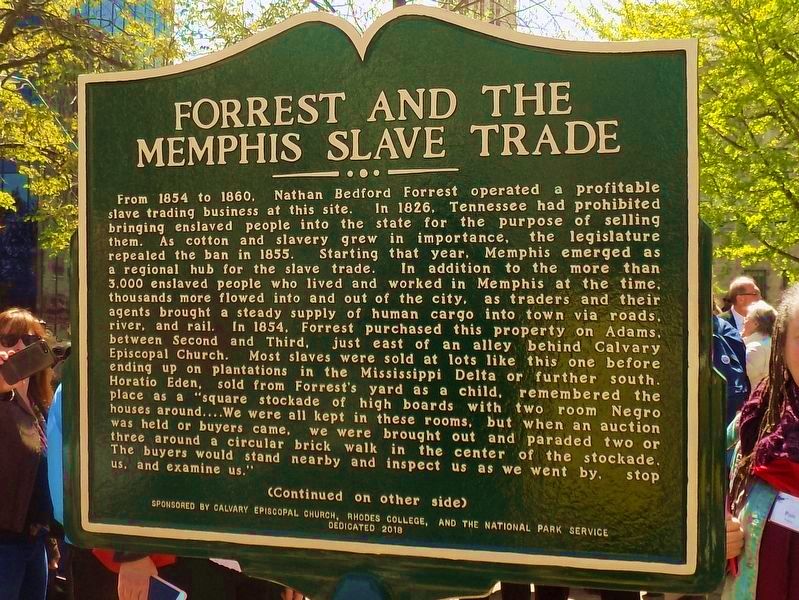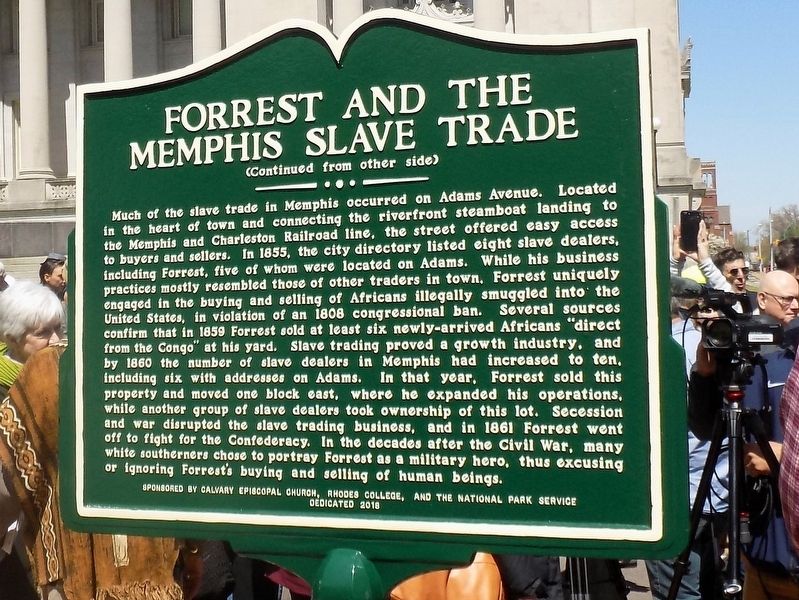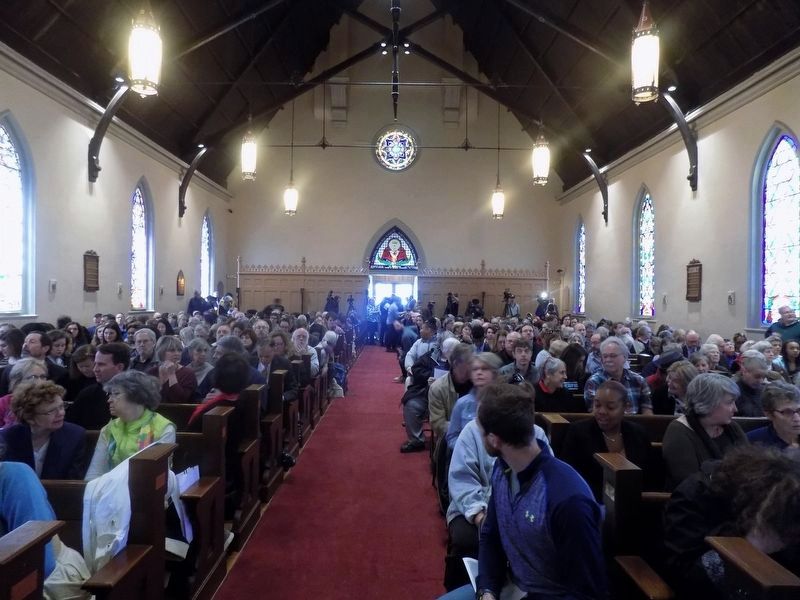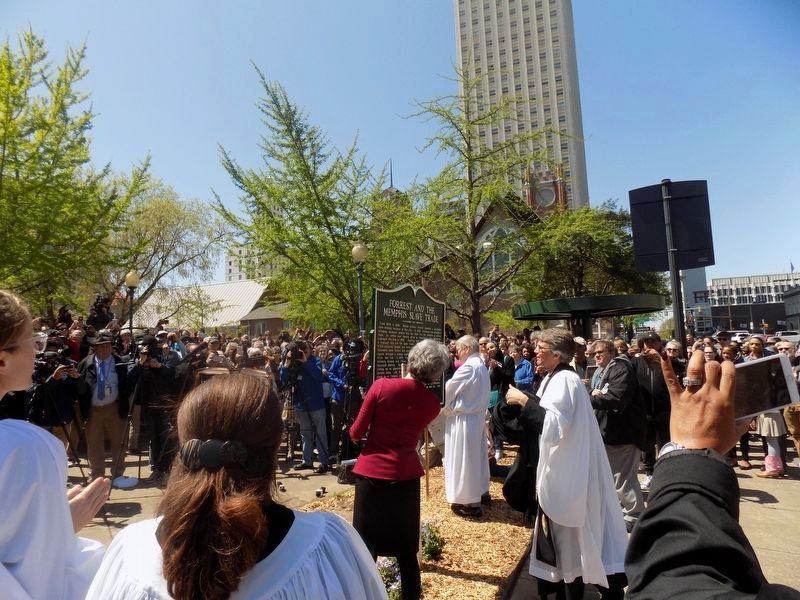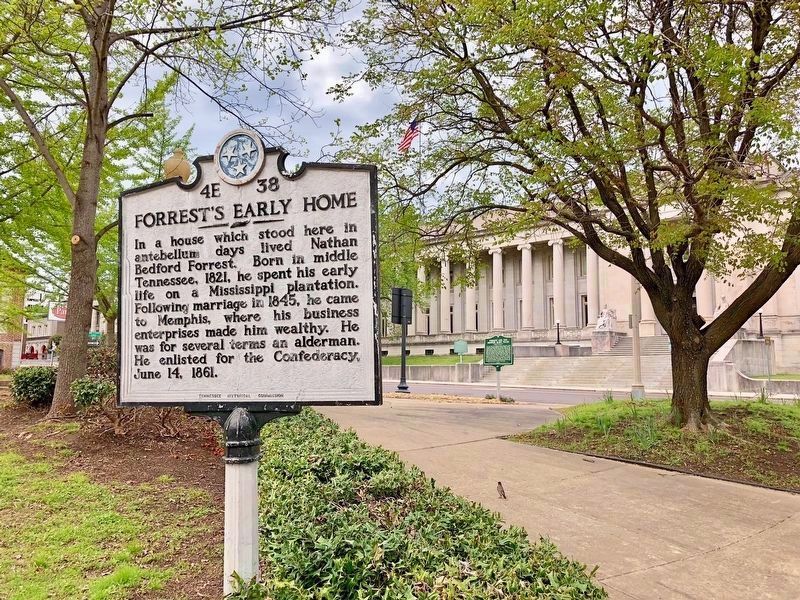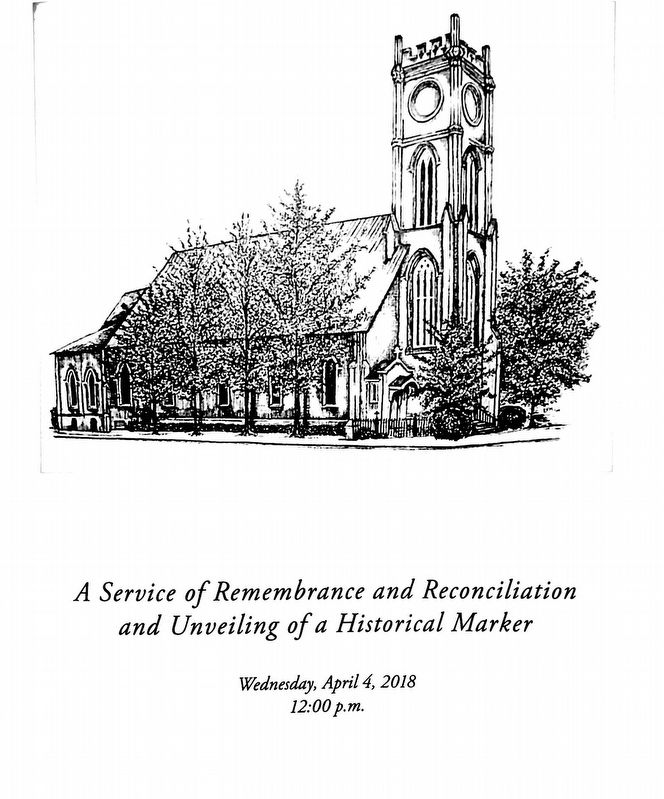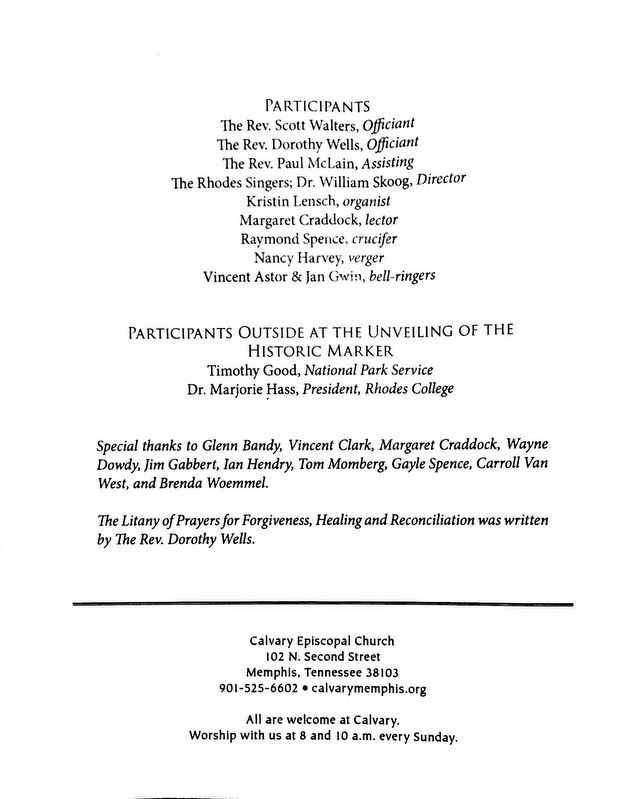Downtown Memphis in Shelby County, Tennessee — The American South (East South Central)
Forrest and the Memphis Slave Trade
From 1854 to 1860, Nathan Bedford Forrest operated a profitable slave trading business at this site. In 1826, Tennessee had prohibited bringing enslaved people into the state for the purpose of selling them. As cotton and slavery grew in importance, the legislature repealed the ban in 1855. Starting that year, Memphis emerged as a regional hub for the slave trade. In addition to the more than 3000 enslaved people who lived and worked in Memphis at the time, thousands more flowed in and out of the city, as traders and their agents brought a steady supply of human cargo into town via roads, river, and rail. In 1854, Forrest purchased this property on Adams, between second and Third, just east of an alley behind Calvary Episcopal Church. Most slaves were sold at lots like this one before ending up on plantations in the Mississippi Delta or further south. Horatio Eden, sold from Forrest's yard as a child, remembered the place as a "square stockade of high boards with two room Negro houses around...We were all kept in these rooms, but when an auction was held or buyers came, we were brought out and paraded two or three times around a circular brick walk in the center of the stockade. The buyers would stand nearby and inspect us as we went by, stop us, and examine us."
(continued from the other side)
Much of the slave trade in Memphis occurred on Adams Avenue. Located in the heart of town and connecting the riverfront steamboat landing to the Memphis and Charleston Railroad line, the street offered easy access to buyers and sellers. In 1855, the city directory listed eight slave dealers, including Forrest, five of whom were located on Adams. While his business practices resembled those of other traders in town, Forrest uniquely engaged in the buying and selling of Africans illegally smuggled into the United States, in violation of an 1808 congressional ban. Several sources confirm that in 1859 Forrest sold at least six newly-arrived Africans "direct from the Congo" at his yard. Slave trading proved a growth industry, and by 1860 the number of slaver dealers in Memphis had increased to ten, including six with addresses on Adams. In that year, Forrest sold this property and moved one block east, where he expanded his operations, while another group of slave dealers took ownership of this lot. Secession and war disrupted the slave trading business, and in 1861 Forrest went off the fight for the Confederacy. In the decades after the Civil War, many white southerners chose to portray Forrest as a military hero, thus excusing or ignoring Forrest's buying and selling of human beings.
Erected 2018 by Calvary Episcopal Church, Rhodes College, and the National Park Service.
Topics. This historical marker is listed in these topic lists: African Americans • War, US Civil. A significant historical year for this entry is 1854.
Location. This marker has been replaced by another marker nearby. 35° 8.851′ N, 90° 2.961′ W. Marker has been damaged. Marker is in Memphis, Tennessee, in Shelby County. It is in Downtown Memphis. Marker is at the intersection of Adams Avenue and B.B. King Boulevard (Tennessee Route 14), on the right when traveling east on Adams Avenue. Located in the area that was once called Columbus Park. Touch for map. Marker is at or near this postal address: 102 North 2nd Street, Memphis TN 38103, United States of America. Touch for directions.
Other nearby markers. At least 8 other markers are within walking distance of this location. Statuary at the Shelby County Courthouse (within shouting distance of this marker); St. Peter Catholic Church (within shouting distance of this marker); Shelby County Courthouse (within shouting distance of this marker); Forrest's Early Home (within shouting distance of this marker); 1862 Post Office (within shouting distance of this marker); Calvary Protestant Episcopal Church (about 300 feet away, measured in a direct line); Eugene Magevney (about 300 feet away); Let Freedom Ring (about 300 feet away). Touch for a list and map of all markers in Memphis.
More about this marker. The following text is from the dedication ceremony. In 2015 the Lynching Sites Project of Memphis first drew attention to the fact that the existing marker at B.B. King and Adams, placed by the Tennessee Historical Commission in 1955, referred only to Nathan Bedford Forrest's becoming wealthy from his "business enterprises" without revealing that he traded in enslaved people. A year later, Tim Huebner, Professor of History at Rhodes College and a member of Calvary Church, discovered that the existing marker actually stood at the site of Forrest's antebellum slave mart. In other words, Calvary's current parking lot was once one of city's most active slave trading sites. With the support of the people of Calvary, in fall 2017 Prof. Huebner invited his students to research the history of slavery and the slave trade in Memphis in his "historical methods" course at Rhodes, with the ultimate goal of writing the text for a new marker. Local scholars helped to edit the final version of the text, and the Tennessee Civil War Heritage Area and the National Park Service provided further support.
Related marker. Click here for another marker that is related to this marker. Original Marker ignoring Forrest's slave dealing history. Was erected in 1955, one year after the landmark Brown vs. The Board of Education of Topeka Kansas.
Also see . . . New Historic Marker Highlights Nathan Bedford Forrest’s Ties to the Slave Trade. An earlier marker only noted the Confederate general, widely believed to be the Ku Klux Klan’s first leader, became wealthy from his ‘business enterprises’ (Submitted on April 6, 2018, by Steve Masler of Memphis, Tennessee.)
Additional commentary.
1. Marker vandalized.
This marker was broken off at its base in an apparent act of vandalism this past Saturday. The broken marker is being stored at the nearby Calvary Episcopal Church and the church plans to have it restored or replaced.
— Submitted July 20, 2020, by Mark Hilton of Montgomery, Alabama.
2. Marker has been replaced.
Calvary Episcopal Church rededicated the replacement marker at the former site of a slave market run by Nathan Bedford Forrest. The replacement event was held in Calvary Park in observance of the Feast of Martin Luther King Jr. on Wednesday, April 7, 2021.
— Submitted April 9, 2021, by Mark Hilton of Montgomery, Alabama.
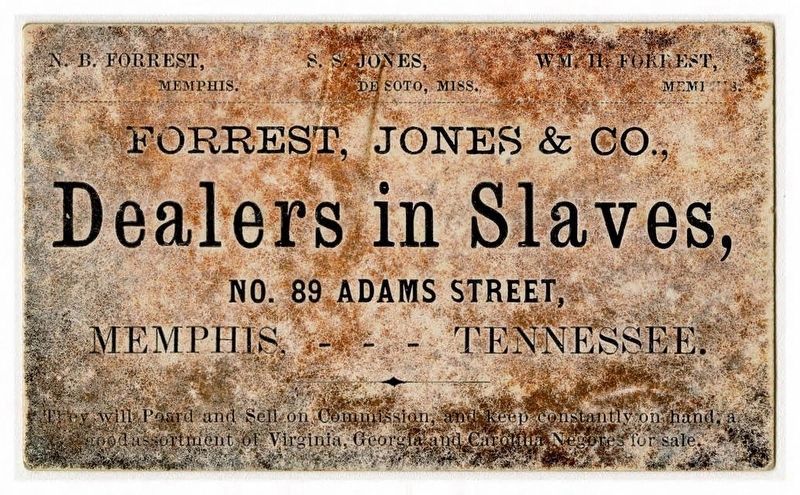
image courtesy of the Tennessee State Library and Archives
8. Business card advertising Forrest, Jones & Co. as "Dealers in Slaves"
"Located at No. 89 Adams Street, Memphis, Tennessee, the owners of this slave-dealing business included Nathan Bedford Forrest, later a famous Confederate general during the Civil War, and his brother William. The bottom of the business card reads, "They will Board and Sell on Commission, and keep constantly on hand, a good assortment of Virginia, Georgia, and Carolina Negroes for sale." On the reverse of the card is written in pencil, "Sold Madison to Forrest," possibly referring to an enslaved person sold to Forrest by the owner of Belle Meade plantation near Nashville. Four enslaved individuals were killed in this brick building on Jan. 13, 1860 when it collapsed following heavy rains; Forrest, one of Memphis' largest slave dealers and wealthiest men, closed the business soon afterwards." - Tennessee State Library and Archives
Credits. This page was last revised on February 7, 2023. It was originally submitted on April 5, 2018, by Steve Masler of Memphis, Tennessee. This page has been viewed 4,062 times since then and 503 times this year. Last updated on May 6, 2018, by Byron Hooks of Sandy Springs, Georgia. Photos: 1, 2, 3, 4. submitted on April 5, 2018, by Steve Masler of Memphis, Tennessee. 5. submitted on April 14, 2018, by Mark Hilton of Montgomery, Alabama. 6, 7. submitted on April 5, 2018, by Steve Masler of Memphis, Tennessee. 8. submitted on February 24, 2020. • Andrew Ruppenstein was the editor who published this page.
